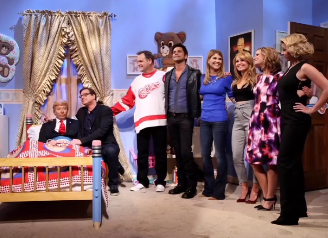
Before the era of streaming and endless content options, families would gather in the living room every week to watch TV together. For millions of Americans in the late ’80s and early ’90s, Full House was one of those must-watch shows. Premiering in 1987 and running for eight seasons, Full House wasn’t edgy or overly complicated. It was simple, sweet, and unapologetically heartwarming.
In a time when many sitcoms leaned on sarcasm or adult humor, Full House carved out a niche by delivering laughter with life lessons—and that feel-good formula became the blueprint for family shows that followed.
The Story That Hooked America
The premise of Full House was straightforward: Danny Tanner, a recently widowed father of three young girls—D.J., Stephanie, and Michelle—recruits his brother-in-law Jesse and best friend Joey to help him raise his kids. Three grown men trying to raise children in a shared house? Sounds like chaos, right? It was—but in the most charming way possible.
The series balanced goofy humor with heartfelt emotion, blending slapstick moments with tearjerking family talks. Whether it was Michelle learning a life lesson or Uncle Jesse facing his own fears, every episode aimed to leave you smiling—and thinking.
Why It Worked: A Cast That Clicked
Part of what made Full House such a hit was its chemistry. Bob Saget as Danny brought warmth and structure. John Stamos, as Jesse, added coolness and edge. Dave Coulier’s Joey provided the comic relief with silly impressions and catchphrases like “Cut it out!”
But the real magic? The kids. Candace Cameron (D.J.), Jodie Sweetin (Stephanie), and the Olsen twins (as Michelle) became household names. Watching them grow up onscreen created a strong bond with viewers. These weren’t just characters—they felt like family.
Themes That Connected With Audiences
At its core, Full House was about more than parenting—it was about teamwork, love, forgiveness, and making room for second chances. The show didn’t shy away from hard topics like loss, peer pressure, lying, growing pains, and even death. But it handled them in a way that was digestible for children and meaningful for parents.
This balance helped the show become a go-to choice for family viewing. It gave parents an opportunity to talk about real-life issues with their kids after each episode ended.
The Power of Predictability and Positivity
In today’s world of plot twists and gritty dramas, a show like Full House might seem “too soft.” But back then, that softness was its strength. People knew what they were going to get each week: a problem, a funny misunderstanding, a heartfelt talk (cue the emotional music), and a group hug. That consistency made it comforting—like a warm blanket after a long day.
And let’s be honest, who didn’t want a hug from Uncle Jesse or Joey after a rough moment?
Its Role in the TGIF Lineup
ABC’s TGIF (Thank Goodness It’s Friday) programming block was a cultural phenomenon in the ’90s, and Full House was its crown jewel. It opened the door for other family shows like Family Matters, Step by Step, and Boy Meets World.
Together, they created a weekly routine for families to laugh and connect. In many ways, Full House set the tone for an entire generation of sitcoms aimed at blending family values with humor.
Cultural Impact Beyond the Screen
Even outside the show, Full House had major influence. The Olsen twins became global superstars. “You got it, dude!” became one of the most quoted TV lines ever. Jesse and the Rippers (Jesse’s band) had real fans. And that San Francisco house? It’s a tourist attraction to this day.
It became more than a show—it was a symbol of a simpler, happier time, and its impact reached far beyond TV ratings.
Criticism and Backlash: Too Wholesome?
Of course, not everyone was a fan. Critics sometimes dismissed Full House as overly sentimental or cheesy. Some felt its solutions were too clean, too fast, and not reflective of real-life complexity.
But here’s the thing: Full House wasn’t trying to be gritty. It wasn’t trying to shock you or dive into moral gray areas. It wanted to be a show you could watch with your kids, your grandparents, and your little cousins—together. That was its whole mission.
Legacy and Rebirth
Decades later, Full House remains a pop culture touchstone. Its reboot, Fuller House, which aired on Netflix from 2016 to 2020, proved just how much love there still is for the Tanners. While it didn’t hit the same cultural heights, it reintroduced familiar characters to a new generation and gave longtime fans a nostalgic reunion.
Conclusion
Full House didn’t win a ton of awards. It wasn’t critically acclaimed. But what it gave us was arguably more important—it gave us warmth, laughter, and a sense of belonging. In an often chaotic world, it offered a reminder that love and family (no matter how unconventional) always matter most.
And maybe that’s why, even today, when the world feels overwhelming, some of us still hit play on an old Full House episode—just to hear Michelle say, “You got it, dude.”
